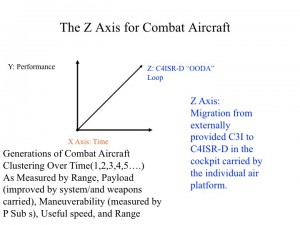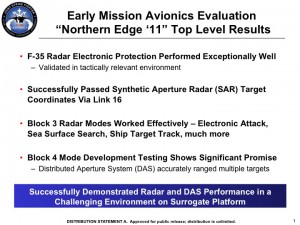08/31/2011 by Ed Timperlake
Just as Washington begins its political dive into 2012 and the budget drill, Northern Edge 2011 provides a focal point for the restructuring of U.S. power projection forces. In a robust jamming operating environment, the F-35 radar and distributed aperture system (DAS) separated themselves from the pack, and have initiated a new era in thinking in combat operations.
As a Joint Program Office release underscores this is not only about the ability of airpower to operate in a robust EW environment in which cyber conflict is a key dimension but it is about the ability of an airborne capability to support maritime operations.
Participating in Northern Edge for the second time, F-35 Joint Strike Fighter sensor capabilities were tested in Alaska’s premier multi-operational environment from June 13-24, 2011. Hosted by Alaskan Command, Northern Edge is a biennial U.S. Pacific Command exercise that prepares joint forces to respond to crises throughout the Asia-Pacific region.
This year provided an invaluable opportunity to observe the performance of the F-35 JSF systems in multiple robust electronic warfare scenarios.
The AN/APG-81 active electronically scanned array radar (AESA) and AN/AAQ-37 distributed aperture system (DAS) were mounted aboard Northrop Grumman’s BAC 1-11 test aircraft. Making its debut, the AN/AAQ-37 DAS demonstrated spherical situational awareness and target tracking capabilities. The DAS is designed to simultaneously track multiple aircraft in every direction, which has never been seen in an air combat environment.
A return participant, the AN/APG-81 AESA demonstrated robust electronic protection, electronic attack, passive maritime and experimental modes, and data-linked air and surface tracks to improve legacy fighter situational awareness. It also searched the entire 50,000 square- mile Gulf of Alaska operating area for surface vessels, and accurately detected and tracked them in minimal time.
Navy Cmdr. Erik Etz, Deputy Mission Systems Integrated Product Team Lead from the F-35 JSF Program Office, said the rigorous testing of both sensors during NE 2011 served as a significant risk-reduction step for the F-35 JSF program. “By putting these systems in this operationally rigorous environment, we have demonstrated key war fighting capabilities well in advance of scheduled operational testing,” Etz added.
Having the exercise in June had its seasonal weather challenges for system operators to adapt and overcome. Inclement and cloudy weather hampered in-flight visibility. The DAS was significant in providing clear and discernable horizons, and views of ground features and nearby aircraft. It also wasn’t dark enough for testing night vision functions. A surrogate test visor was used for displaying DAS imagery to the operators. “The implications of F-35 JSF sensor systems for air-land-sea battle are immense,” said Peter Bartos, Northrop Grumman’s Test Director.
http://www.jsf.mil/news/docs/20110627_NORTHERNEDGE.pdf
The F-35 is not a linear performance enhancement from F/A-18 4th Gen; it has a third performance axis “Z” The “Z” axis is the pilot’s cockpit C4ISR-D “OODA” loop axis.
Traditionally, the two dimensional depiction is that the x-axis is time and the y-axis is performance and captures individual airplanes that tend to cluster in generation improvement. Each aircraft clustered in a “generation” is a combination of improvements. Essentially, the aeronautical design “art” of blending together ever improving and evolving technology eventually creates improvements in a linear fashion.
The design characteristics blended together prior to F-35 have been constantly improving range, payload (improved by system/and weapons carried), maneuverability (measured by P Sub s), useful speed, and range (modified by VSTOL–a plus factor). The F-35 is also designed with inherent survivability factors-first redundancy and hardening and then stealth. Stealth is usually seen as the 5th Gen improvement.
But reducing the F-35 to a linear x-y axis improvement or to stealth simply misses the point. The F-35 is now going to take technology into a revolutionary three-dimensional situational awareness capability. This capability establishes a new vector for TacAir aircraft design. This can be measured on a “Z” axis.

In addition, the learning curve to improve sensors, system capability and weapons carried quickly compared to building another airframe may be a new American way of industrial surging. The American arsenal of democracy may be shifting from an industrial production line to a clean room and a computer lab as key shapers of competitive advantage. This process is now progressing along the revolutionary “Z-axis.”
https://sldinfo.com/the-f-35b-in-the-perspective-of-aviation-history/
Consequently, in both Northern Edge 2009 and 2011 the baseline was being re-normed and legacy aircraft shown to be just that.
And a robust jamming or cyber environment is something that those who believe unmanned systems are the only future of airpower would soon see in combat demonstrations that they are not.
Rather than a key element of the future it would be wise to grasp that UAS have not been tested in a contested air combat environment nor their accident rate really discussed.
If someone figures out what happens when Cyber Warriors fight UAS Drivers then maybe it will be time for some speculation. But early hard budgeting decisions to substitute reliance on UAS as a direct trade off for fighter pilots is yet to be validated in a demanding combat environment.
UAS primacy advocates have yet to produce a robust test in which the entire mission profile for a UAS was pitted against dedicated Cyber Warriors. A cyber team that was allowed to employ all of their techniques available-from jamming, spoofing, malware, denial of service, Trojans, backdoors, viruses, worms and even finding a deliberate saboteur (there are some evolving CI programs that look for such action) think PFC Manning and Wiki-leaks.
Additionally, UAS accident rates have not been addressed. As Col. (retired) Bill Buckey, a Marine F/A-18 Combat Pilot, LSO and the officer who directed the surge build out at Kandahar Afghanistan points out; “The accident rate for UAS ops at Kandahar was noticeable and that harsh environment is less demanding than a pitching Carrier Deck–an operational environment that includes CV ops is as of yet uncharted territory for UAVs.”
Northern Edge validated, in real time, the ability of American and soon allied TacAir fleets to have each combat pilot have total concurrent situational awareness. The C4ISR-D (for decision) in each cockpit takes the F-35 out of the linear 5th Gen development path. The slide on “Early Mission Evaluation “Northern Edge ‘11” Top Level Results show us that development path.

The F-35 Radar was validated in a tactically relevant environment—until proven otherwise America is still the most capable EW and to use an older phrase ECCM (Electronic Counter Counter Measures) fighting force in the world. So being tactically “validated” in an American designed exercise is the gold standard.
Northern Edge exercises provide operational, not test, environments.
Block 2 is ready for Marine F-35B IOC. Block 2 was the first improvement up the Z-axis-in 2009 and pilots from the Marine Air Weapons Training Squadron, MAWTS (Marine equivalent of “Top Gun”) are paying close attention.
Block 3 — the next step up the Z-axis–demonstrated that the radar worked effectively in sea surface search and ship target track. If American TacAir forces afloat can see an enemy they will kill that enemy. So much for the future of PLAN surface combatants and their contribution to the “wasting asset” argument.
A very easily understandable simple Northern Edge take away—the F/A-18 can not do what the F-35 C4ISR-D can do in combat. Why modernize backward? Why even have a trade off paper drill unless the plan is to relegate the Navy Carrier Battle Group with F/A-18s in support as tankers, and launching HARMs (high speed anti-radiation missiles) in flying the Suppression of Enemy air defense mission, while the air-to-air battle is fought with F-35s, USAF F-22s, and Aegis? With an F/A-18 Air wing the CV will still have to tactically trade distance for effectiveness.
Block 4 is the next step up for “3 Dimensional Warriors” and a “Z-Axis” cockpit. A fighter pilot very familiar with Northern Edge when asked about DAS said it had a feature of “Passive Ranging.” When asked what that meant he casually remarked:
“Shooting people off your tail and all the stuff”—
As a Marine F-4 pilot with 2000 hours in the Phantom II T/M/S I sure wish I had had that capability. His was a simple matter of fact statement that will powerfully resonate in every USAF, USN, USMC and Allied Ready Room. The Fighter pilots of today will be the air commanders of the future and know what is at stake.
Having flown the F-35 simulator I found it to be a solid aircraft and actually easy to fly. Operating within the technological paradigm of constant “Z-Axis” improvements for enhanced situational awareness of both friend and foe. The F-35 “OODA loop” capabilities will lead to revolutionary tactics since the emerging way of American and Allied war is that no platform fights alone.
The pilots want the F-35, and now indicators are that Combatant Commanders know the story of Northern Edge and believe it is their needed quest to get the F-35 into the fleet and onto airfields to fight and survive for decades to come.
(For comments by an F-18 pilot on the transition to the F35 see
https://sldinfo.com/shaping-an-economy-of-force-a-usmc-f-18-pilot-comments-on-the-f-35b/
and
https://sldinfo.com/a-usmc-f-18-pilot-discusses-the-transition-to-the-f-35/).

